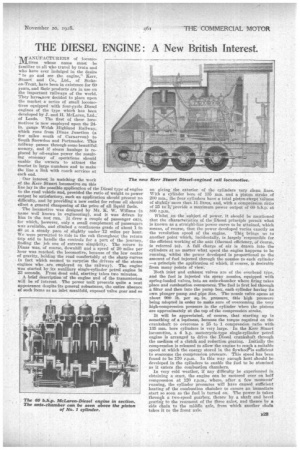THE DIESEL ENGINE: A New British Interest.
Page 19

If you've noticed an error in this article please click here to report it so we can fix it.
MANUFACTURERS of locomotives whose name must be familiar to all who travel by train and who have ever indulged in the desire "to go and see the engine," Kerr, Stuart and Co., Ltd., of Stokeon-Treat, have been in existence for 60 years, and their products are in use on the important railways of the world. They havesmow decided to place upon the market a series of small locomotives equipped with fourleyde Diesel engines of the type which has been developed by J. and H. McLaren, Ltd., of Leeds. The first of these locomotives is now employed upon the 24in. gauge Welsh Highland Railway, which runs from Dinas Junction (a few miles south of Carnarven). to South Snowdon and Portmadoc. ThiS railway passes through some beautiful scenery, and if steam haulage is replaced by oil-engine power the resulting economy of •operations should enable the owners to attract the tourist in large numbers and to make the line a link with coach services at each end.
Our interest in watching the work of the Kerr Stuart locomotive an this line lay in the possible application of the Diesel type of engine to the road vehicle and, provided the ratio of weight to power output be satisfactory, such an application should present no difficulty, and by providing a new outlet for refuse oil should effect a general cheapening of the price of all liquid fuels.
The locomotive was designed by Mr. K. W. Winans fa name well known in engineering), and it was driven by him in the test run. It drew a couple of passenger cars, for which, however, only a small complement of passengers was available, and climbed a continuous grade of about 1 in 40 at a steady pace of slightly under 12 miles per hour. We were permitted to ride in the cab throughout the return trip and to handle the controls for a part of the journey, finding the job one of extreme simplicity. The return to Dines was, of course, downhill and a speed of 20 miles per hour was reached, the locomotive, because of the low centre of gravity, holding the road comfortably at the sharp curves (a fact which seemed to surprise the drivers of the steam engines who . are employed on the railway). The engine was started by its auxiliary single-cylinder petrol engine in 33 seconds. From dead cold, starting takes two minutes.
A brief description of the engine and of the transmission will be of interest. The power unit presents quite a neat appearance despite its general robustness, the entire absence of such items as an inlet manifold, exposed valve gear and so
on giving, the. exterior of the cylinders very clean. lines. With a cylinder' bore of 135 rum. and a PiSton Stroke. of 200 mm., the four cylinders have a total piston-sivept Volume of slightly more than 11 litres, and, with a campreSsion ratio of 25 to -L.-Provide a Maximum power output of (10 b.h.p. at 800 r.p.m.
Whilst on the ,subject of power, it should be mentioned that the cliaracteriSties of the,"Diesel principle permit -what is known as a straight-line poWer curve to be attained, which means, of course, that the power developed varies exactly as
the revolution speed of the engine. This brings us to another point which, theidentally, is largely responsible for the efficient working of the unit (thermal efficiency, of curse, is referred to). A full charge of air is drawn into the cylinders at no matter what speed the engine happens to be running, whilst the power developed is proportional to the amount of fuel injected through the nozzles to each cylinder —a principle the application of which, if course, is desirable from many points of view.
'Both inlet and exhaust valves are of the overhead type, and the fuel is injected via sPray nozzles, equipped with spring-loaded valves, into an mite-chamber where firing takes place and combustion commences. The fuel is first led through a filter and then into the primp box, each cylinder having its own plunger pump and pipe line. The nozzle valve opens at about 900 lb. per sq. in. pressure, this high pressure being adopted in order to make sure of overcoming the very high-compression pressure in the cylinder when the pistons are approximately at the tap of the compression stroke.
It will be appreciated, of course, that starting rip is something of a business, because the torque required on the crankshaft to overcome a 25 to 1 compression ratio with 135 mm. bore cylinders is very large. In the Kerr Stuart locomotive, a 4 h.p. motorcycle-type single-cylinder petrol engine is arranged to drive the Diesel crankshaft through the medium of a clutch and redaction gearing. Initially the compression is released to allow the engine to reach a suitable speed at which the energy stored in the flywheefis sufficient to overcome the compression pressure. This speed has been found to be 170 Limn. In this way enough heat should be developed in the cylinders to enable the fuel to be atomized as it enters the combustion chambers.
In very cold weather, if any difficulty be experienced in obtaining a start, the engine can be motored over on half compression at 120 r.p.m., xvhere, after a few moments' running, the cylinder pressures -will have caused sufficient heating of the combustion chataber to ensure an immediate start so soon as the fuel is turned on. The power is taken throuih a two-speed gearbox, thence by a -shaft and bevel gearing to the rearmost of the three axles, and thence by a side chain to the middle axle, from which another chain takes it to the front axle.








































